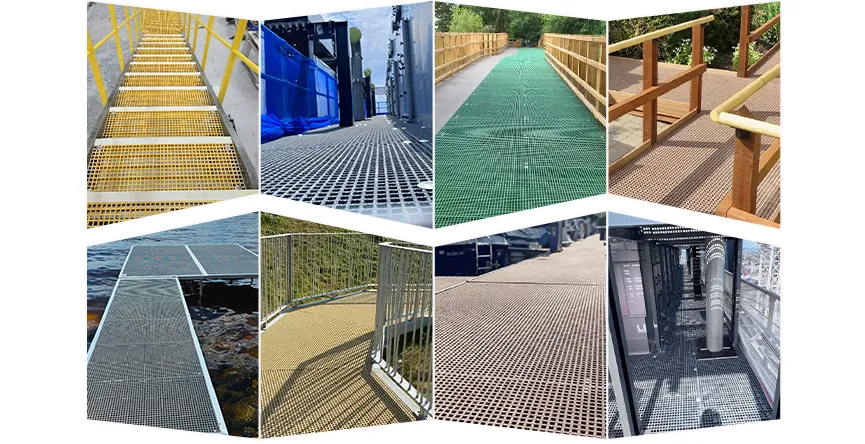loading...
- No. 9, Xingyuan South Street, Dongwaihuan Road, Zaoqiang County, Hengshui, Hebei, China
- admin@zjcomposites.com
- +86 15097380338
- Welcome to visit our website!
Innovative Fiber Reinforced Polymer Railing Solutions for Enhanced Safety and Aesthetics
The Benefits of FRP Railing Systems in Modern Construction
In the ever-evolving landscape of construction materials, fiberglass reinforced polymer (FRP) railing systems have emerged as a prominent solution for various architectural and safety needs. With their unique combination of durability, aesthetic appeal, and low maintenance requirements, FRP railing systems are revolutionizing the way we approach building safety and design.
Understanding FRP Materials
FRP consists of a polymer matrix reinforced with fiberglass, which provides exceptional strength-to-weight ratios and corrosion resistance. Unlike traditional materials such as wood, steel, or aluminum, FRP does not rust, rot, or deteriorate when exposed to harsh environmental conditions. This makes it an ideal choice for outdoor applications and environments that experience extreme weather fluctuations, including coastal areas where saltwater corrosion is a concern.
Durability and Longevity
One of the foremost advantages of FRP railing systems is their impressive durability. FRP can withstand heavy impacts and harsh environmental stressors without compromising structural integrity. This resilience translates to longer service life compared to traditional materials, reducing the frequency and costs associated with repairs and replacements.
Additionally, FRP railings are resistant to UV radiation, preventing excessive fading and degradation over time. This characteristic ensures that the railings maintain their aesthetic appeal for years, without the need for staining or painting that often comes with wood or metal counterparts.
Safety Features
Safety is paramount in construction, particularly in spaces where public access is involved. FRP railing systems provide excellent grip and stability, ensuring that users can navigate stairs, balconies, and walkways without fear of slipping or falling. The material's inherent strength allows for designs that can accommodate various height requirements and load-bearing capacities.
Furthermore, FRP can be manufactured with non-conductive properties, making it a safe choice around electrical installations or for maritime applications where grounding is crucial. This non-conductive feature reduces the risk of electrical shock, providing an added layer of safety for users.
frp railing systems

Aesthetic Flexibility
Beyond functionality, FRP railing systems offer remarkable design flexibility. Manufacturers can produce these railings in a variety of colors, patterns, and finishes, allowing architects and designers to tailor them to specific projects. Whether for residential properties, commercial buildings, or public infrastructure, FRP railings can complement diverse architectural styles, from modern to traditional.
Moreover, FRP can be molded into intricate designs and shapes, providing an opportunity for creativity that traditional materials may not offer. This versatility enables designers to craft visually appealing spaces while adhering to safety regulations.
Low Maintenance Requirements
One of the most appealing features of FRP railing systems is their low maintenance requirements. Unlike wood, which may need regular sealing, painting, or varnishing, or metal, which often rusts and requires treatments, FRP railings can often be cleaned with simple soap and water. This ease of maintenance translates to lower long-term costs for building owners and managers, allowing for a more cost-effective approach to property management.
Environmentally Friendly Option
As sustainability becomes increasingly important in construction, FRP railing systems present an eco-friendly alternative. The production process for FRP materials often produces less waste than traditional materials, and their durability means less frequent replacement, contributing to a reduction in environmental impact. Additionally, many manufacturers are now focused on producing recyclable FRP products, further enhancing their sustainability profile.
Conclusion
In summary, FRP railing systems offer a compelling mix of durability, safety, aesthetic appeal, and low maintenance, positioning them as a leading choice for modern construction projects. As the industry continues to innovate, embracing materials like FRP will not only enhance the safety and longevity of structures but also contribute to more sustainable building practices. Emphasizing these benefits can empower architects, builders, and property owners to make informed decisions that align with contemporary standards of quality and environmental responsibility.
-
The Rise of FRP Profiles: Strong, Lightweight, and Built to LastNewsJul.14,2025
-
SMC Panel Tanks: A Modern Water Storage Solution for All EnvironmentsNewsJul.14,2025
-
GRP Grating: A Modern Solution for Safe and Durable Access SystemsNewsJul.14,2025
-
Galvanized Steel Water Tanks: Durable, Reliable, and Ready for UseNewsJul.14,2025
-
FRP Mini Mesh Grating: The Safer, Smarter Flooring SolutionNewsJul.14,2025
-
Exploring FRP Vessels: Durable Solutions for Modern Fluid HandlingNewsJul.14,2025
-
GRP Structures: The Future of Lightweight, High-Performance EngineeringNewsJun.20,2025
